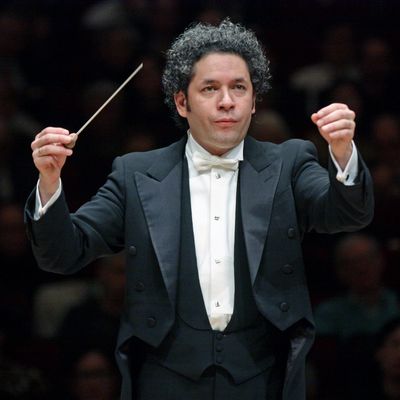
Even a well-worn symphony can shock, in a concert hall. If you’ve never heard Shostakovich’s Symphony No. 5 before, the fact that audience members around you are conducting it in their heads doesn’t mute the raucous passions, the clashing of iron plates, the tunes that swirl together boastfulness and regret. It’s always new to someone. And even if you do know the work, epiphanies can be repeated. Experiencing surprise in a familiar classic is like losing your virginity a second time, a rare and miraculous occurrence. The promise of every performance is that you’ve never heard it like this.
Gustavo Dudamel intends to electrify his listeners, and he wants them to know it. The springy body language, the way the point of his baton slashes the air in Zorro strokes, the rock-climbing poses, arms stretching toward invisible handholds — all of it signals to the sedentary public at his back that he and the band are working hard to keep you not just alert but amazed.
But music goes deeper than mere amazement. Conducting his much-lionized Los Angeles Philharmonic at Geffen Hall, Dudamel flooded Shostakovich’s Fifth with so much wattage that it bleached the shadows and registered only peaks and silhouettes. Buffeted by white-water rapids of sound, I missed the shades of Stalin-era gloom. Shostakovich mastered the art of Soviet expressions, reticence, and evasiveness cloaked in brilliant bombast; Dudamel blew away all the subtexts in a barrage of highlights. I was electrified, the way a fence is: constantly, and not always rewardingly.
At 37, and nearly a decade into his tenure as the L.A. Philharmonic’s music director, Dudamel is well past the phase where he can run on sheer enthusiasm, even if it is supercharged with technique. He likes big noises (so do I), and he never seems happier than when he’s unleashing a joyous clamor of brass and percussion. The performance he led of Edgard Varèse’s 1918 Amériques made the work a contender for loudest unamplified music of the 20th century. It’s an effect that comes not just from the sheer buildup of decibels, but also from Dudamel’s skill with sledgehammer accents and his penchant for rubbing spicy dissonances for every drop of glorious pain. Varèse, a freshly disembarked immigrant from France, portrayed New York at a time that made today’s construction boom look wan, and the performance was heavy on urban cacophony and light on insolence and swagger.
There is something competitive about Dudamel’s yearning for excitement, as if he were trying to wrest a record from his predecessor at the L.A. Philharmonic, Esa-Pekka Salonen. At Lincoln Center, he led the New York Premiere of Salonen’s Pollux, who can likewise spur on players until they start to foam. But Pollux indulges in moderation, too. A slow ground bass, like a giant’s trudge, undergirds wisps of playful murk. Not everything is obvious, snapping, or loud. Either the piece is more tentative than Salonen’s music usually is, or Dudamel doesn’t quite have its measure. In any case, the result was oddly diffuse.
Dudamel’s riskiest move was to offer as an encore a passage from Wagner that demands a supremely delicate touch. In his hands, the famous “Love-Death” from Tristan und Isolde, hardened into slow-drying concrete, not so much weightless and transcendent as squelching and dense.


